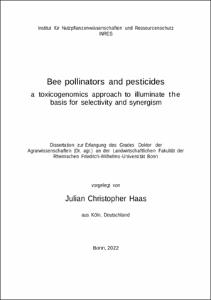Haas, Julian Christopher: Bee pollinators and pesticides : a toxicogenomics approach to illuminate the basis for selectivity and synergism. - Bonn, 2022. - Dissertation, Rheinische Friedrich-Wilhelms-Universität Bonn.
Online-Ausgabe in bonndoc: https://nbn-resolving.org/urn:nbn:de:hbz:5-67551
Online-Ausgabe in bonndoc: https://nbn-resolving.org/urn:nbn:de:hbz:5-67551
@phdthesis{handle:20.500.11811/10254,
urn: https://nbn-resolving.org/urn:nbn:de:hbz:5-67551,
author = {{Julian Christopher Haas}},
title = {Bee pollinators and pesticides : a toxicogenomics approach to illuminate the basis for selectivity and synergism},
school = {Rheinische Friedrich-Wilhelms-Universität Bonn},
year = 2022,
month = sep,
note = {Bees are the most important pollinators in many ecosystems including agroecosystems. Reports of declining bee populations in abundance and diversity are therefore alarming. Many factors are involved in the decline of bees and insects in general. Insecticides and especially neonicotinoid insecticides have been at the center of attention for the last decade. While thorough pollinator risk assessment schemes exist in most countries which have helped to reduce acute bee poisoning events by insecticides, several areas with substantial knowledge gaps have been identified in course of the scientific debate over the impact of pesticides on bees. These areas include for example the toxicity of pesticide mixtures, the appropriateness of the honey bee (Apis mellifera) as a surrogate species for other bee species or the general toxicokinetic behavior of pesticides in bees. Some of these questions are difficult to answer with classic methodologies but can be addressed with the help of molecular and biochemical approaches within the field of toxicogenomics.
(Honey) bees possess an evolutionary adapted detoxification system against many diverse xenobiotics. This detoxification system is also capable to soften and mitigate the effects of insecticides. Especially cytochrome P450 enzymes have been shown to be an integral part of the honey bees defense system against several insecticidal chemotypes. Here, the knowledge of this important enzyme family in bees is expanded and leveraged to improve the evaluation of pesticides regarding their bee safety profile.
In chapter 2 a fluorescence-based, high-throughput in-vitro assay is described to assess the risk of synergistic interaction between mixture partners due to the inhibition of important P450s enzymes the most frequent reason for synergistic interactions observed in bees. In chapter 3 the molecular determinants of the reduced bee toxicity of the butenolide insecticide flupyradifurone were investigated in detail revealing the importance of the cytochrome P450 isoforms CYP6AQ1, CYP9Q2 and CYP9Q3 for its detoxification. In chapter 4 the involvement of these enzymes in chlorantraniliprole metabolism was investigated fostering the role of CYP9Q2+3 in the detoxification of various chemical classes. Considering those findings the appearance of orthologs of these essential determinants of insecticide selectivity is investigated across 75 bee species and by recombinant expression of 26 CYP9Q-related genes from 20 bee species the functional similarity was validated (chapter 5).
Together, these results contribute significantly to the understanding of insecticide toxicology in bees, help to understand insecticide selectivity issues, may complement current risk assessment procedures for the evaluation of pesticide safety and can support the development of novel, next-generation insecticides with a further improved environmental profile.},
url = {https://hdl.handle.net/20.500.11811/10254}
}
urn: https://nbn-resolving.org/urn:nbn:de:hbz:5-67551,
author = {{Julian Christopher Haas}},
title = {Bee pollinators and pesticides : a toxicogenomics approach to illuminate the basis for selectivity and synergism},
school = {Rheinische Friedrich-Wilhelms-Universität Bonn},
year = 2022,
month = sep,
note = {Bees are the most important pollinators in many ecosystems including agroecosystems. Reports of declining bee populations in abundance and diversity are therefore alarming. Many factors are involved in the decline of bees and insects in general. Insecticides and especially neonicotinoid insecticides have been at the center of attention for the last decade. While thorough pollinator risk assessment schemes exist in most countries which have helped to reduce acute bee poisoning events by insecticides, several areas with substantial knowledge gaps have been identified in course of the scientific debate over the impact of pesticides on bees. These areas include for example the toxicity of pesticide mixtures, the appropriateness of the honey bee (Apis mellifera) as a surrogate species for other bee species or the general toxicokinetic behavior of pesticides in bees. Some of these questions are difficult to answer with classic methodologies but can be addressed with the help of molecular and biochemical approaches within the field of toxicogenomics.
(Honey) bees possess an evolutionary adapted detoxification system against many diverse xenobiotics. This detoxification system is also capable to soften and mitigate the effects of insecticides. Especially cytochrome P450 enzymes have been shown to be an integral part of the honey bees defense system against several insecticidal chemotypes. Here, the knowledge of this important enzyme family in bees is expanded and leveraged to improve the evaluation of pesticides regarding their bee safety profile.
In chapter 2 a fluorescence-based, high-throughput in-vitro assay is described to assess the risk of synergistic interaction between mixture partners due to the inhibition of important P450s enzymes the most frequent reason for synergistic interactions observed in bees. In chapter 3 the molecular determinants of the reduced bee toxicity of the butenolide insecticide flupyradifurone were investigated in detail revealing the importance of the cytochrome P450 isoforms CYP6AQ1, CYP9Q2 and CYP9Q3 for its detoxification. In chapter 4 the involvement of these enzymes in chlorantraniliprole metabolism was investigated fostering the role of CYP9Q2+3 in the detoxification of various chemical classes. Considering those findings the appearance of orthologs of these essential determinants of insecticide selectivity is investigated across 75 bee species and by recombinant expression of 26 CYP9Q-related genes from 20 bee species the functional similarity was validated (chapter 5).
Together, these results contribute significantly to the understanding of insecticide toxicology in bees, help to understand insecticide selectivity issues, may complement current risk assessment procedures for the evaluation of pesticide safety and can support the development of novel, next-generation insecticides with a further improved environmental profile.},
url = {https://hdl.handle.net/20.500.11811/10254}
}






